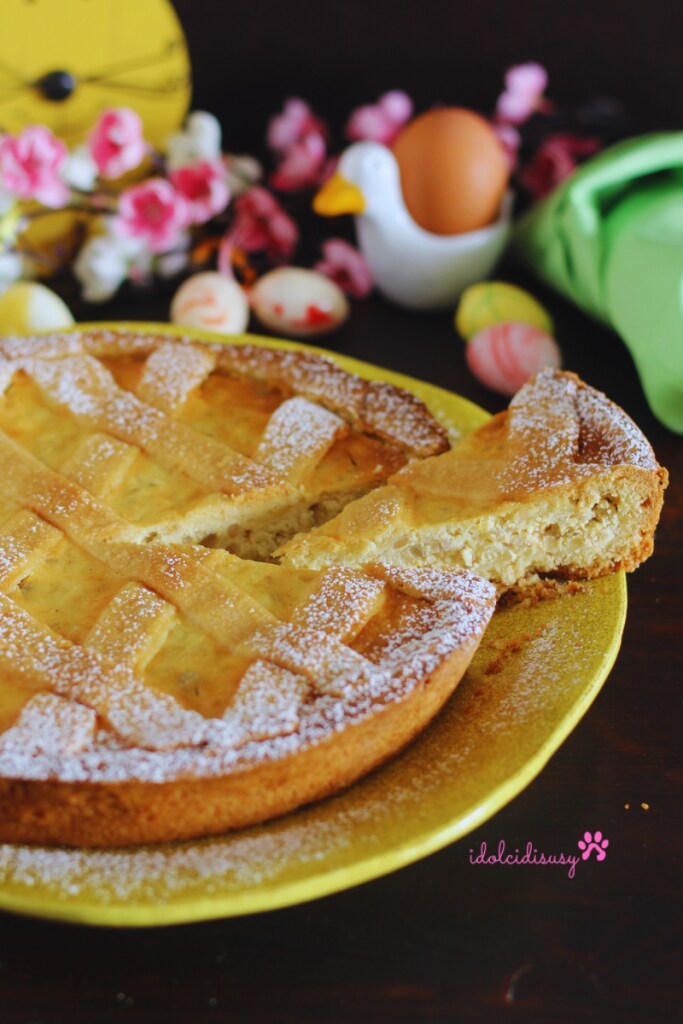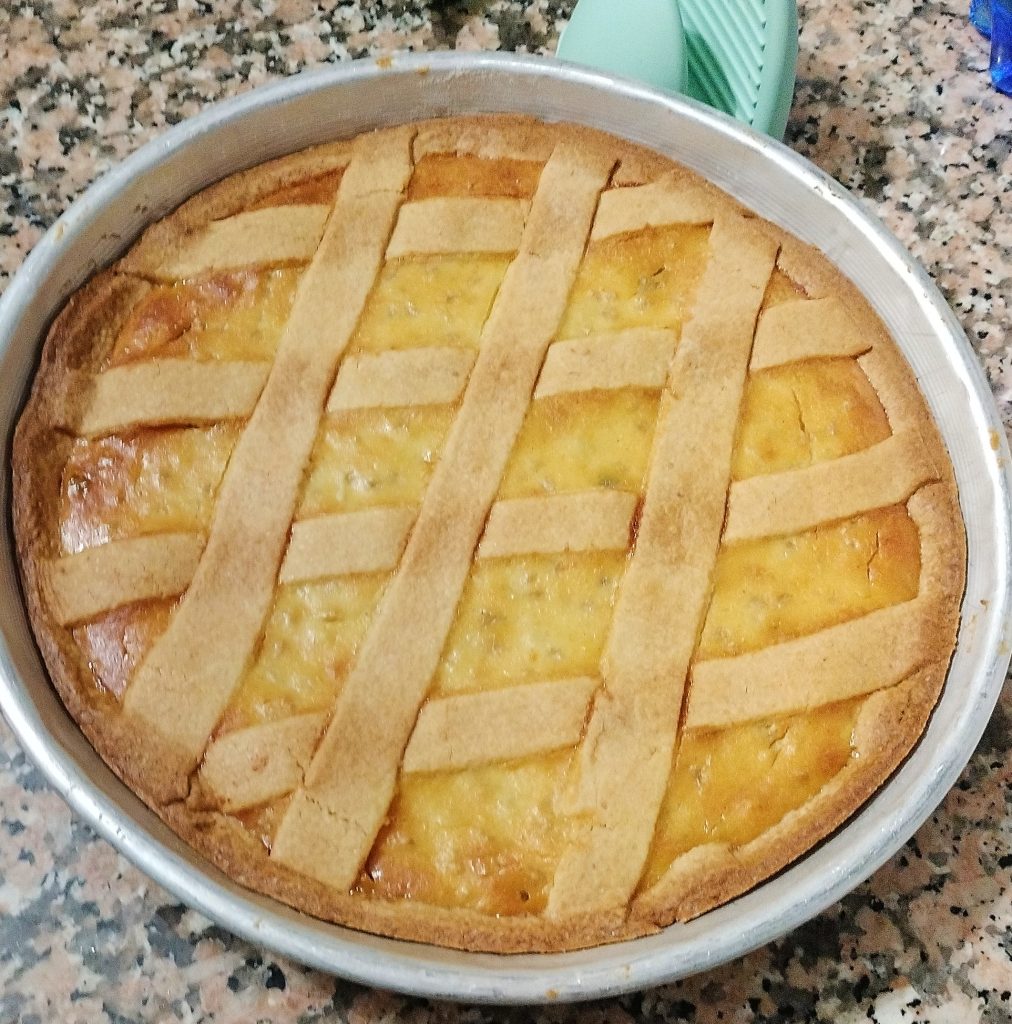The Neapolitan Pastiera: Traditional Recipe! A typical Neapolitan dessert, mainly prepared during the Easter period.
A tart of shortcrust pastry filled with a cream made of ricotta, cooked wheat, eggs, candied fruit, and flavors like orange blossom and cinnamon. The result? A fragrant, creamy dessert with a unique texture.
It is quite an elaborate and lengthy recipe; traditionally, it should be prepared on Holy Thursday to rest for three days, until Easter Sunday.
Every Neapolitan family has its own version of the pastiera, passed down through generations. A dessert that encapsulates the history of Naples, with intense aromas and an immense love for cooking.
Preparing the pastiera is not just a recipe; it’s a ritual. I make it for my family every year and gift some to our friends along with Easter cookies.
Absolutely a must-try, and if you try it, let yourself be enveloped by its scents and magic… Well, let’s discover together the recipe of the traditional Neapolitan pastiera!
I’ll see you on my Facebook page, on my Instagram profile, TikTok on Pinterest, and on my YouTube channel with my videos for a greeting and a comment.
See you soon, Susy
Try also👇

- Difficulty: Medium
- Cost: Medium
- Rest time: 2 Days
- Preparation time: 1 Hour
- Portions: 12
- Cooking methods: Oven
- Cuisine: Italian
- Energy 569.79 (Kcal)
- Carbohydrates 78.07 (g) of which sugars 43.99 (g)
- Proteins 11.59 (g)
- Fat 25.01 (g) of which saturated 11.37 (g)of which unsaturated 12.44 (g)
- Fibers 2.37 (g)
- Sodium 198.46 (mg)
Indicative values for a portion of 154 g processed in an automated way starting from the nutritional information available on the CREA* and FoodData Central** databases. It is not food and / or nutritional advice.
* CREATES Food and Nutrition Research Center: https://www.crea.gov.it/alimenti-e-nutrizione https://www.alimentinutrizione.it ** U.S. Department of Agriculture, Agricultural Research Service. FoodData Central, 2019. https://fdc.nal.usda.gov
Ingredients for the Neapolitan Pastiera: Traditional Recipe
- 4 cups all-purpose flour
- 1 cup granulated sugar
- 7 oz lard (or butter)
- 2 eggs (medium size)
- 1 egg yolk
- 1 lemon zest (grated)
- 1 pinch salt
- 14 oz cooked wheat
- 1/2 cup whole milk
- 2 tbsps butter
- 2 tbsps sugar
- 1 lemon zest
- 14 oz sheep ricotta
- 1 cup sugar
- 3 eggs
- 1/2 tsp ground cinnamon
- 1/4 cup candied citron
- 1/4 cup candied orange
- 1 tbsp orange blossom water
- 1 lemon zest (grated)
- 1 orange zest (grated)
- powdered sugar
You’ll Need
- Aluminum Pan 9.5 inches and 1.5 inches high (pastiera mold)
- Hand Whisk
Preparing the Neapolitan Pastiera: Traditional Recipe
On the work surface, I pour the flour and arrange it in a fountain shape, place the slightly softened butter in the center, the grated lemon zest, the pinch of salt, and sugar, and quickly knead with my hands. Then, I add the whole egg and the yolk and continue kneading.
I compact the dough well and form the dough ball, wrap it in plastic wrap, and let it rest in the fridge for a couple of hours. The rest is essential to allow the crust to absorb the aroma well and become more elastic.
Meanwhile, in a non-stick pot, I put the well-drained wheat, the milk, a tablespoon of sugar, the lemon zest, and the butter.
I cook on low heat, stirring occasionally for about 20 minutes; the milk should be completely absorbed by the wheat.
I let it cool at room temperature to then be added to the ricotta cream.
I put the fresh ricotta in a fine mesh strainer and let it drain to make it less watery. I transfer it to a bowl and add the sugar, grated lemon and orange zests, the tablespoon of orange blossom water, cinnamon, and start mixing everything with a hand whisk; the sugar must dissolve well. Then, I add the eggs one at a time, always with the hand whisk, making sure they are well absorbed, and lastly, I add the candied fruits. I mix with a spatula and add the now-cooled grain cream.
I let it rest in the fridge for a few hours so it blends well, becoming creamier.
I take the crust out of the fridge and roll it out with a rolling pin on a lightly floured board. Then, I place it in the pan, level the edges by cutting off the excess dough, make the classic holes with a fork, and pour the filling. Then, I proceed with the classic tart strips; traditionally, there should be 7 strips because they form a diamond grid representing, according to popular tradition, the seven decumani of Naples, which are the ancient main streets of the Greco-Roman city.
The pastiera is ready; I put it in the fridge for a couple of hours to prevent it from puffing up too much during baking. After the time has passed, I simply need to bake at 340°F for about 1 and a half hours.
The baking should be gentle and long, and when the surface is slightly golden, I can turn off the oven.
I then turn off the oven and let it rest for at least 20 minutes with the oven door open.
Finally, our pastiera is ready; it is certainly a lengthy recipe but worth it; after all, it’s too good.
Lastly, but not least, is to let it rest and dry well at room temperature before tasting it. This is because we can appreciate all its endless nuances of scent and flavor.
I finish the pastiera with a sprinkle of powdered sugar.

Storage
The pastiera can be stored at room temperature, in a cool and dry place for a week, away from heat sources for a couple of days. If there are leftovers, I recommend keeping it in the fridge for another 2 days.
The legend about the pastiera says that…
One night, the fishermen’s wives left baskets on the beach with ricotta, candied fruit, orange blossoms, eggs, and wheat as an offering to the sea, so it would allow their safe return home. Returning to the beach the next morning, they had a wonderful surprise; the sea waves mixed all the ingredients, creating the Pastiera.

